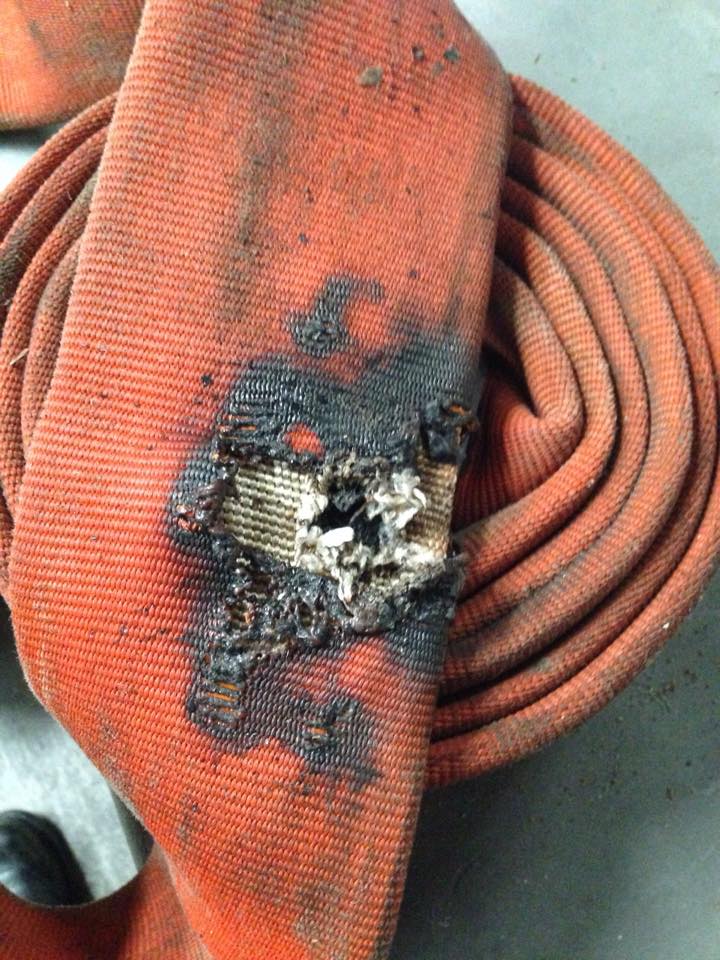Lets take a moment to talk about how to protect yourself from thermal failure of hose issues regardless of spec. Hose line burn through is potentially a significant factor in some LODDs. Neglect of basic hose line handling and maintenance along with improper hose spec are the major contributing factors to burn through.
Consider the following:
- You should be aware that hose will fail roughly at the same temperature (a bit lower) than your face piece.
- The section of hose under stress can be remote from you and will give you no warning. You will not feel heat, you will not see flames, you will be unaware hose failure is occurring behind you.
- Hose can and will fail from both radiated heat and direct conduction of heat. The best way to protect your hose is to flow water during your advance cooling both surfaces and gases.
- Hose is particularly vulnerable when it makes transitions between floors where it is exposed to higher temperatures. Typically this is in basement fires as you transition to the cooler floor below. Remember, the hose behind you is in the high heat area. (Consider Air Track / Flow Path) Basement fires must be extinguished quickly as the clock is ticking towards hose failure.
- Basement fires that have side access doors (preferably at or near basement floor grade) should be used as the primary entrance to basement fires if possible. Above grade floors can be protected by secondary handlines and closed doors. This should also be considered for structure fires on hills as well where entering above the fire floor.
- Do not make it worse, coiling hose against a wall, feeding it high into a corner, or placing it higher then necessary inside the fire building can expose the hose to significantly higher temperatures. These techniques may make the advance easier, but I teach that all of them are bad practice, where handline hose will possible be exposed to heat (we crawl low for a reason).
- A charged hose line only offers protection against burn through by flowing water on the hot surfaces and cooling the fire environment. Static charged hose is not protected, dry and charged hose lines have almost identical failure times. It does not matter whether the damage is done during a dry or wet stretch. (ATF and WPI research currently supports this position)
- Watch for signs of failure, synthetic hose melts and pops as it fails.
- Get your agency to discuss the above and have everyone on the fire ground understand how to protect their lines. Ideally the handline is charged and flowing with a high application rate (small lines between 150-185gpm, large lines between 250-300gpm). All lines should be near 50psi at the tip to reduce nozzle reaction and ensure flow is possible while advancing.
- Get your chiefs to understand that all hose is not the same. For example do not spec hose for "light weight" as this removes material that protects against burn through and other mechanical insults that occur on every fire ground.. The reduction in weight is almost certainly not worth it in most applications. Ensure it is made out of higher grade polyester or nylon 6-6 with a melt temp of around 485F. Cheaper hose can melt in the lower 400F range.
- Inspect your hose after every fire especially the working and interior lengths. Wash it off with the reel line on scene. Do a quick working pressure test, load it back with an intentional rotation: working length goes on first then the next length in reverse. You want all of your hose to share the work and be exposed to similar fire duty over the hoses life cycle. You should never have all of the beat up hose at the nozzle and then clean hose further back. This is a sign of a failure to understand how to take care of your hose. It is clear indicator of missing knowledge of best hose practices at a department and something I look for every time I take a picture of a rig. (This includes supply line!)
Finally, as with all LODD I have found it is difficult to know what has occurred and which were the first dominoes to fall. Hose line burn through in my mind is always a possibility on the fire ground. ATF and WPI LODD research after the Boston Backbay incident has turned up many fires were there was a burn through and a LODD. I believe understanding and implementing the above points will help lower that necessary risk. I say necessary risk because anytime a hose is pulled thermal failure is possibility while combating fire.
Images (1)(2) courtesy of ATF, Image (3) Dennis LeGear



